About Breast Cancer
From time to time, a woman or her
doctor may find breast changes, such as
Breast changes to look out for:
A lump, lumpiness or
thickening. For younger women - if this is not related to your normal
monthly cycle and remains after your period. For women of all ages - if
this is a new change in one breast only.
a new change in one breast only.
-
Changes to the
nipple: such as a change in shape, crusting, a sore or an ulcer, redness
or in-drawing of the nipple.
-
Discharge from the
nipple: if this is from one nipple and is bloodstained, or occurs without
squeezing.
-
Changes in the skin
of the breast: such as any puckering or dimpling of the skin, unusual
redness or other colour change.
-
Persistent unusual
pain: if this is not related to your normal monthly cycle, remains after
your period and occurs in one breast only.
-
Change in the size or
shape of the breast: this might be either an increase or a decrease in
size.
It is important that all breast
changes are carefully investigated. If it is cancer, finding it early
will mean a much better chance of effective treatment. See your doctor
straight away if you find a breast change.
 During the first week
or two after your diagnosis, you will probably be asked to make decisions
about treatment. At this time you might still be feeling shocked and
confused, so you might find it helpful to talk about your treatment
options with your doctors, family and friends. Seek as much information as
you feel you need.
During the first week
or two after your diagnosis, you will probably be asked to make decisions
about treatment. At this time you might still be feeling shocked and
confused, so you might find it helpful to talk about your treatment
options with your doctors, family and friends. Seek as much information as
you feel you need.
Breast cancer is a disease in
which malignant cells form in the tissues of the breast.
The breast is made up of lobes and ducts. Each breast has 15 to 20 sections
called lobes, which have many smaller sections called lobules. Lobules end in
dozens of tiny bulbs that can produce milk. The lobes, lobules, and bulbs are
linked by thin tubes called ducts.
Each breast also has blood vessels and lymph vessels. The lymph vessels carry an
almost colourless fluid called lymph. Lymph vessels lead to organs called lymph
nodes. Lymph nodes are small bean-shaped structures that are found throughout
the body. They filter substances in lymph and help fight infection and disease.
Clusters of lymph nodes are found near the breast in the axilla (under the arm),
above the collarbone, and in the chest.
 The most common type of breast cancer is
ductal carcinoma, which begins in the cells of the ducts. Cancer that begins in
the lobes or lobules is called lobular carcinoma and is more often found in both
breasts than are other types of breast cancer. Inflammatory breast cancer is an
uncommon type of breast cancer in which the breast is warm, red, and swollen.
The most common type of breast cancer is
ductal carcinoma, which begins in the cells of the ducts. Cancer that begins in
the lobes or lobules is called lobular carcinoma and is more often found in both
breasts than are other types of breast cancer. Inflammatory breast cancer is an
uncommon type of breast cancer in which the breast is warm, red, and swollen.
Age and health history can affect the risk of developing breast cancer.
Anything that increases your chance of getting a disease is called a risk
factor. Risk factors for breast cancer include:
-
Older age.
-
Menstruating at an early age.
-
Older age at first birth or
never having given birth.
-
A personal history of breast
cancer or benign breast disease.
-
A mother or sister with breast
cancer.
-
Treatment with radiation
therapy to the breast/chest.
-
Breast tissue that is dense on
a mammogram.
-
Hormone use (such as oestrogen
and progesterone).
-
Drinking alcoholic beverages.
-
Caucasian race.
Breast cancer is sometimes
caused by inherited gene mutations. The genes in cells carry the hereditary
information that is received from a personís parents. Hereditary breast cancer
makes up approximately 5% to 10% of all breast cancer. Some altered genes
related to breast cancer are more common in certain ethnic groups.
Women who have an altered gene related to breast cancer and who have had breast
cancer in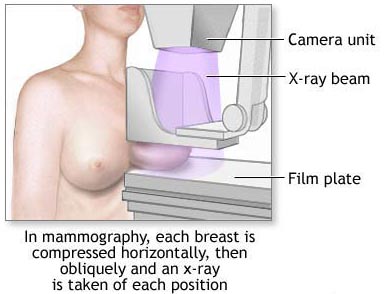 one breast have an increased risk of developing breast cancer in the
other breast. These women also have an increased risk of developing ovarian
cancer, and may have an increased risk of developing other cancers. Men who have
an altered gene related to breast cancer also have an increased risk of
developing this disease.
one breast have an increased risk of developing breast cancer in the
other breast. These women also have an increased risk of developing ovarian
cancer, and may have an increased risk of developing other cancers. Men who have
an altered gene related to breast cancer also have an increased risk of
developing this disease.
Tests have been developed that can detect altered genes. These genetic tests are
sometimes done for members of families with a high risk of cancer.
Tests that examine the breasts are used to detect and diagnose breast cancer.
A doctor should be seen if changes in the breast are noticed. The following
tests and procedures may be used:
- Mammogram: An x-ray of the breast
- Biopsy: The removal of cells or tissues so they can be viewed under a microscope
to check for signs of cancer. If a lump in the breast is found, the doctor may
need to cut out a small piece of the lump. A pathologist views the tissue under
a microscope to look for cancer cells. Four types of biopsies are as follows:
- Excisional biopsy: The removal
of an entire lump or suspicious tissue.
- Incisional biopsy: The removal
of part of a lump or suspicious tissue.
- Core biopsy: The removal of
part of a lump or suspicious tissue using a wide needle.
- Needle
biopsy or fine-needle aspiration biopsy: The removal of part of a lump,
suspicious tissue, or fluid, using a thin needle.
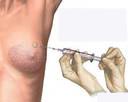 Oestrogen and progesterone
receptor test: A test to measure the amount of oestrogen and progesterone
(hormones) receptors in cancer tissue. If cancer is found in the breast, tissue
from the tumour is examined in the laboratory to find out whether oestrogen and
progesterone could affect the way cancer grows. The test results show whether
hormone therapy may stop the cancer from growing.
Oestrogen and progesterone
receptor test: A test to measure the amount of oestrogen and progesterone
(hormones) receptors in cancer tissue. If cancer is found in the breast, tissue
from the tumour is examined in the laboratory to find out whether oestrogen and
progesterone could affect the way cancer grows. The test results show whether
hormone therapy may stop the cancer from growing.
Certain factors affect treatment options and prognosis (chance of recovery).
The treatment options and prognosis (chance of recovery) depend on the stage of
the cancer (whether it is in the breast only or has spread to other places in
the body), the type of breast cancer, certain characteristics of the cancer
cells, and whether the cancer is found in the other breast. A womanís age,
menopausal status (whether a woman is still having menstrual periods), and
general health can also affect treatment options and prognosis.
Treatment
Options

Cancer treatment may vary depending upon
the type of cancer, the stage of cancer and the goal of treatment. Often, one or
more treatments may be used in order to provide the most complete treatment for
the patient. Increasingly, it is common to use several treatments concurrently
or in sequence, with the goal of preventing both local and systemic recurrence.
These treatments may include surgery, radiation therapy, chemotherapy and/or
biological therapy.
Depending on the stage of cancer, one or
more treatments may be required to achieve the best results. Cancer treatments
aim to prevent the cancer from spreading locally or recurring/relapsing at sites
distant from the original location (metastasis). Cancer therapy may consist of
one or more treatment modalities delivered concurrently or in sequence,
including surgery, radiation, chemotherapy, and/or biologic therapy.
Surgery: Surgery is a local treatment used to
remove visible tumours. In addition, surgeons frequently remove the tissue
adjacent to the cancer during surgical resection of a tumour. Information gained
about the tumour during surgery is useful in predicting the likelihood of tumour
recurrence and the need for other treatment modalities.
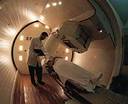 Radiation Therapy: Radiation therapy, or radiotherapy, uses
high-energy rays to damage or kill cancer cells by preventing them from growing
and dividing. Similar to surgery, radiation therapy is a local treatment used to
eliminate or eradicate visible tumours. Radiation therapy is not typically
useful in eradicating cancer cells that have already spread to other parts of
the body. Radiation therapy may be externally or internally delivered. External
radiation delivers high-energy rays directly to the tumour site from a machine
outside the body. Internal radiation, or brachytherapy, involves the
implantation of a small amount of radioactive material in or near the cancer.
Radiation Therapy: Radiation therapy, or radiotherapy, uses
high-energy rays to damage or kill cancer cells by preventing them from growing
and dividing. Similar to surgery, radiation therapy is a local treatment used to
eliminate or eradicate visible tumours. Radiation therapy is not typically
useful in eradicating cancer cells that have already spread to other parts of
the body. Radiation therapy may be externally or internally delivered. External
radiation delivers high-energy rays directly to the tumour site from a machine
outside the body. Internal radiation, or brachytherapy, involves the
implantation of a small amount of radioactive material in or near the cancer.
Chemotherapy: Chemotherapy is the general term for any
treatment involving the use of drugs 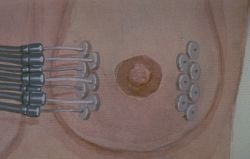 to kill cancer cells. Cancer chemotherapy
may consist of single drugs or combinations of drugs. Chemotherapy can be
administered through a vein, injected into a body cavity or delivered orally in
the form of a pill. Chemotherapy is different from surgical or radiation therapy
in that the cancer-fighting drugs circulate in the blood to parts of the body
where the cancer may have spread and can kill or eliminate cancers cells at
sites great distances from the original tumour. As a result, chemotherapy is
considered a systemic treatment.
to kill cancer cells. Cancer chemotherapy
may consist of single drugs or combinations of drugs. Chemotherapy can be
administered through a vein, injected into a body cavity or delivered orally in
the form of a pill. Chemotherapy is different from surgical or radiation therapy
in that the cancer-fighting drugs circulate in the blood to parts of the body
where the cancer may have spread and can kill or eliminate cancers cells at
sites great distances from the original tumour. As a result, chemotherapy is
considered a systemic treatment.
Biological Therapy: Biological therapy is referred to by
many terms including immunologic therapy, immunotherapy, or biotherapy.
Biological therapy is a type of treatment that uses the bodyís immune system to
facilitate the killing of cancer cells. Types of biological therapy include
interferon, interleukin, monoclonal antibodies, colony stimulating factors or
cytokines and vaccines.
 Hormone Therapy:
Hormones are naturally occurring
substances in the body that stimulate the growth of hormone sensitive tissues,
such as the breast or prostate gland. When cancer arises in breast or prostate
tissue, its growth and spread may be caused by the bodyís own hormones.
Therefore, drugs that block hormone production or change the way hormones work,
and/or removal of organs that secrete hormones, such as the ovaries or
testicles, are ways of fighting cancer. Hormone therapy, similar to
chemo, is a systemic treatment in that it may affect cancer cells
throughout the body.
Hormone Therapy:
Hormones are naturally occurring
substances in the body that stimulate the growth of hormone sensitive tissues,
such as the breast or prostate gland. When cancer arises in breast or prostate
tissue, its growth and spread may be caused by the bodyís own hormones.
Therefore, drugs that block hormone production or change the way hormones work,
and/or removal of organs that secrete hormones, such as the ovaries or
testicles, are ways of fighting cancer. Hormone therapy, similar to
chemo, is a systemic treatment in that it may affect cancer cells
throughout the body.
The vast majority of breast changes are
not breast cancer. If you find a lump or other change in your breast or nipple
it might be caused by the following:
Hormonal changes
Hormones produced by glands in the body make a womanís breast feel different at
various times during her menstrual cycle. Women who have been through menopause
and are not taking hormone replacement therapy, or who have had their ovaries
removed, no longer have breast changes due to hormonal activity.
Hormonal changes may cause women to have swollen, painful or tender breasts at
different times in their cycle; these are not a sign of breast cancer and
usually do not require treatment. However, treatments are available for hormonal
breast pain from the doctor, if needed. It may be useful to keep a record of
breast changes prior to menstruating over a couple of months to see whether
there is any pattern to the changes.
Breast cancer
starts in the ducts or lobules of the breast. If the cancer cells spread outside
the ducts or lobules of the breast into the surrounding tissue, this is called
invasive breast cancer. Early breast cancer is an invasive breast cancer.
Invasive cancer cells sometimes spread outside the breast area to other parts of
the body. They do this by moving through blood vessels, such as veins, or
through lymphatic vessels. Lymphatic vessels are next to veins in the body, and
are connected to lymph nodes (glands). Lymph nodes collect normal fluid and dead
cells from the lymphatic vessels.
If the cancer cells are contained in the breast and armpit area, then the cancer
is early breast
 cancer'. If the cancer has spread to places near the breast,
such as the chest
cancer'. If the cancer has spread to places near the breast,
such as the chest (including the skin, muscles or bones of the chest), but the
cancer isn't found in other areas of the body, this is called locally advanced
breast cancer. If the cancer cells spread from the breast and are found in other
areas of the body, such as the bones or the lungs, this is called metastatic
breast cancer.
(including the skin, muscles or bones of the chest), but the
cancer isn't found in other areas of the body, this is called locally advanced
breast cancer. If the cancer cells spread from the breast and are found in other
areas of the body, such as the bones or the lungs, this is called metastatic
breast cancer.
Pre-invasive' breast cancer is another
type of breast cancer. Pre-invasive breast cancer is the name for abnormal
cells or cancer cells that stay inside the milk ducts or milk sacs (lobules) of
the breast. Ductal carcinoma in situ (DCIS) and lobular carcinoma in situ (LCIS)
are types of pre-invasive breast cancer.
Cysts
A cyst is a fluid-filled sac. Fluid is produced and absorbed by the breast as
part of the usual cycle of hormonal breast changes. Although we donít know why
some women are more susceptible to breast cysts than others, we do know they are
common in women aged 35 to 50 and in women who are taking hormone replacement
therapy.
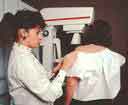 Simple cysts are
not cancer and do not change into cancer. However, in rare cases, cysts may have
a cancer growing within them or close to them. These changes can be seen on an
ultrasound, or found after a cyst is aspirated or drained. Many women have a
cyst or a number of cysts without knowing it, and they do not usually require
treatment. Some women first detect their cyst as a painful lump and they may
decide to have it drained if it is painful or troublesome. This is done by
inserting a fine needle into the cyst to draw out the fluid, and is usually a
simple and fairly painless procedure.
Simple cysts are
not cancer and do not change into cancer. However, in rare cases, cysts may have
a cancer growing within them or close to them. These changes can be seen on an
ultrasound, or found after a cyst is aspirated or drained. Many women have a
cyst or a number of cysts without knowing it, and they do not usually require
treatment. Some women first detect their cyst as a painful lump and they may
decide to have it drained if it is painful or troublesome. This is done by
inserting a fine needle into the cyst to draw out the fluid, and is usually a
simple and fairly painless procedure.
Regular mammograms
are offered by the French Health system for older women.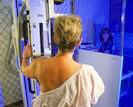
Pagetís disease of the nipple is a rare form of breast cancer that
begins in the milk ducts and spreads to the skin of the nipple and areola (the
area around the nipple).
Fibroadenomas
A fibroadenoma is a smooth, firm breast lump made up of fibrous and glandular
tissue. The term ďbreast mouseĒ is also used to refer to a fibroadenoma. We do
not know the cause of fibroadenomas; however, they are not cancer and rarely
change into breast cancer. Fibroadenomas are more common in younger women and
may become tender in the days before a period or grow bigger during pregnancy.
Women have a choice about whether to have their fibroadenoma removed, but if it
is monitored and continues to enlarge, it should be removed. Most often, younger
women or those with smaller fibroadenomas will not have them taken out. The
operation to remove a fibroadenoma is relatively simple. A general anaesthetic
is usually required.
Heredity and Cancer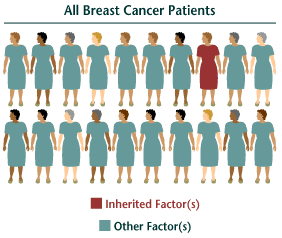
Cancer is not considered an
inherited illness because most cases of cancer, perhaps 80 to 90 percent, occur
in people with no family history of the disease. However, a person's chances of
developing cancer can be influenced by the inheritance of certain kinds of
genetic alterations. These alterations tend to increase an individual's
susceptibility to developing cancer in the future. For example, about 5 percent
of breast cancers are thought to be due to inheritance of particular form(s) of
a "breast cancer susceptibility gene."